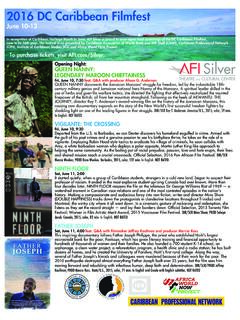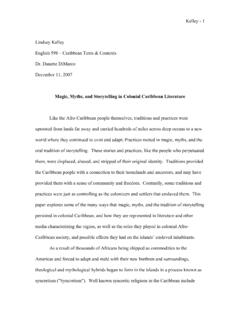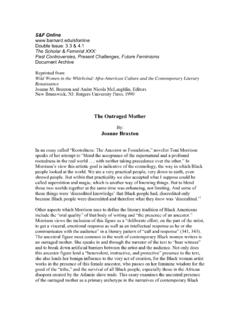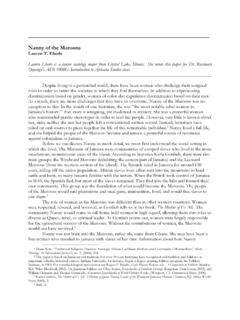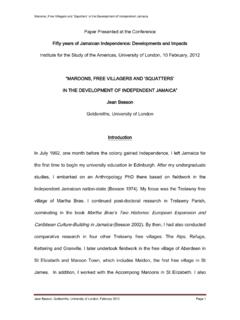Transcription of Jamaica's True Queen - Jah Rootsman
1 Jamaica's true Queen nanny of the Maroons Prepared by Jah Rootsman ina di irit of HIGHER REASONING APRIL 2010 Queen nanny is credited with being the single figure who united the Maroons across jamaica and played a major role in the preservation of African culture and knowledge. Background Queen nanny of the Windward Maroons has largely been ignored by historians who have restricted their focus to male figures in Maroon history.
2 However, amongst the Maroons themselves she is held in the highest esteem. Biographical information on Queen nanny is somewhat vague, with her being mentioned only four times in written historical texts and usually in somewhat derogatory terms. However, she is held up as the most important figure in Maroon history. She was the spiritual, cultural and military leader of the Windward Maroons and her importance stems from the fact that she guided the Maroons through the most intense period of their resistance against the British, between 1725 and 1740. Queen nanny is presumed to have been born around the 1680 s in Africa s Gold Coast (now known as Ghana).
3 She was reported to belong to either the Ashanti or Akan tribe and came to jamaica as a free woman. It is possible that Queen nanny brought slaves of her own, reportedly being of royal African blood. It was not uncommon for African dignitaries to keep slaves. She was said to be married to a man named Adou, but had no children. She died in the 1730 s. Moore Town is now the primary town of the Wind-ward Maroons Jamaica's true Queen By Deborah Gabriel Published Sep 2, 2004 nanny of the Maroons it was founded in 1734 after the British de-stroyed the original Maroon town, which was known as nanny Town.
4 Slaves imported to jamaica from Africa came from the Gold Coast, the Congo and Madagascar. The dominant group among Maroon communities was from the Gold Coast. In jamaica this group was referred to as Coromantie or Koromantee. They were fierce and ferocious fighters with a prefer-ence for resistance, survival and above all freedom and refused to become slaves. Be-tween 1655 until the 1830 s they led most of the slave rebellions in jamaica . Spiritual life was of the utmost importance to the Maroons which was incorporated into every aspect of life, from child rearing to military strategies. Almost every slave rebel-lion involved African spiritual practices.
5 Leaders, such as Queen nanny usually prac-ticed Obeah and were able to instill confi-dence in their followers. Spiritual practices such as Obeah (and voodoo in Haiti) evolved from Africa, and during slavery times were of great significance to the black population. However, under colonial rule as Western culture was imposed on the Carib-bean, these African practices became outlawed and took on negative connota-tions. Historical Maroon Identity and Culture Among Maroon culture, their ancestors are revered and their importance to everyday life is recognized. The past is a source of pride which is both taught and shared.
6 Amongst modern day Maroons, the history of their resistance against slavery is an extreme form of pride that forms a large part of Maroon identity. The story of the Maroons endurance and ability to hold off the British troops for almost eighty years is one that has never been repeated in history. What saw the Maroons through to free-dom were their unfailing courage and determination. Their resistance to slavery drew on the strength of their memory of Africa and its culture. Their African culture and identity instilled in them great confidence and self esteem. So much so, that this dilut-ed the stigma of inferiority imposed by the plantocracy.
7 Therefore, the resistance against slavery by the Maroons was a defense of their culture and identity, their spir-itual and political values and preservation of African civilization. This is why Ma-roon ancestors are an integral part of their day to day lives. At each annual Maroon celebration of the 1739 Peace Treaties there is a private element of the festivities at which only Maroons may attend, where the ancestors are said to visit, including Queen nanny who is honored. The Significance of Women Maroons On the plantations women did not escape the brutality of slavery.
8 Marriage and partner-ships among slaves were prohibited. For those that managed to form unions in secret, they were forced to endure the removal of their offspring who were separated from their mothers soon after birth and sold into slavery. Many women opted for abortions rather than see their babies endure the same fate (slavery) that had befallen them. Furthermore, women on the plantations were physically exploited by their slave masters by rape and other sexual practices that were often quite sadistic. They too endured hard physical la-bor within the household doing domestic work and rearing the children of their slave masters.
9 Some occasionally worked on the plantation itself. By contrast, the Maroon women raised crops and were responsible for most of the agri-cultural output within their communities. The men hunted wild hogs and raided the plan-tations for food and supplies and to free slaves. Often, the plantations were raided to bring back women into the Maroon commu-nities, without which they would be unable to increase their numbers and ensure the survival of the Maroons as a race. Maroon warriors who raided the plantations and freed slaves, wielding huge knives that they used to cut off the heads of the British.
10 The strength of women in Maroon communities stemmed from their position within traditional Ashanti or Akan culture. The Ashanti culture was based on a tradition of warrior nations and a history of proud and respected women. Many Ashanti elements were retained in Maroon language and culture. The Legend of Queen nanny Queen nanny is credited with being the military leader of the Windward Maroons who em-ployed clever strategies which led to their repeated success in battles with the British. She was a master of guerilla warfare and trained Maroon troops in the art of camouflage.
